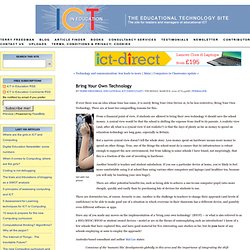

#BYOD - Criteria for Implementation Success #byodchat #edchat. #BYOD - Criteria for Implementation SuccessCreative Commons Copyright ShareAlike-Attribution-NonCommercial This past week in a conversation, I found myself saying, “Wouldn’t it be neat if there was a rubric or list of criteria for implementing a BYOD program?

That way, you could just share that with campus/district leaders so they could be aware of what was needed from 3 different perspectives: Teaching & Learning, Policy and Procedures, and Infrastructure & Administration.” Everyone looked at me with expectation in their faces. Internally, I gave a long sigh. That sigh isn’t unlike the sigh educators give in response to their increasing awareness that crafting a strategy to implement BYOD is important given the following statistics: In light of the facts above, it’s obvious that BYOD is an initiative whose time has come...and, in spite of fears--such as inappropriate social media usage by teachers and students--that may derail it: So, how do schools “get ready” to implement BYOD?
I. II. Byotnetwork. Bring your own technology. If ever there was an idea whose time has come, it is surely Bring Your Own Device or, to be less restrictive, Bring Your Own Technology.

There are at least two comp0elling reasons for this. Girl with her phoneFrom a financial point of view, if students are allowed to bring their own technology it should save the school money. A cynical view would be that the school is shifting the expense from itself to its parents. A realistic view (and, after all, what is a cynical view if not realistic?) Is that the days of plenty as far as money to spend on education technology are long gone, especially in Britain. But a narrow cynical view doesn't tell the whole story. Another benefit is teacher and student satisfaction. There are other potential benefits too, such as being able to achieve a one-to-one computer-pupil ratio more cheaply, quickly and easily than by purchasing lots of devices for students to use. There are downsides too, of course. Australia-based consultant and author Mal Lee states: How would I plan to teach a BYOD class? BYOD Concerns: Education vs. Prohibition « Posted on March 13, 2012 by Oliver Dreon One innovation that is sweeping American institutions of learning is the BYOD (Bring Your Own Device) movement.

The reasons are compelling. Instead of schools and universities purchasing expensive technology and paying for its upkeep, individual students simply use the devices that they already have. A recent ECAR survey reports that over half of collegiate students now own smartphones and over 85% own laptop computers. Simply allowing students to use the devices they already own reduces the financial burden to schools. When schools embrace BYOD, however, new challenges emerge. These studies provide some interesting obstacles for those of us advocating for the BYOD movement. I believe we need to educate students about appropriate use of technology and show students that they will be more productive and more engaged when they focus on a single task without the distractions from Facebook and Twitter.
Like this: Like Loading... Read ''Chromebooks and BYOD Success in Education'' White Paper. Access to Windows Applications and Virtual Desktops—from any device Today's educators and school IT staff face a dynamic environment of exploding content sources and education applications.

Schools are being asked to achieve ‘more with less’ and to enable students and staff to access information and applications from any location, using any device. These developments are compounded by an unclear economic climate, forcing educational institutions to look for less complex and more cost effective methods of providing students, teachers, and staff with access to computing resources. In response to these challenges, Chromebooks have proven to be an innovative solution for schools that need to cut costs while also making teaching and learning resources (for example, applications, desktops, websites) more easily accessible.
This paper examines the challenges that IT professionals face in academic environments and discusses the ways in which Chromebooks directly address those challenges.